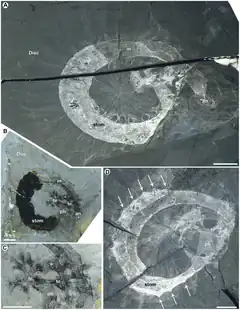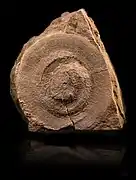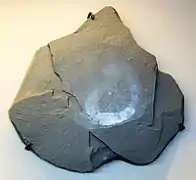Eldonia
Eldonia est un genre éteint d'animaux énigmatiques à corps mou qui ont vécu du Cambrien inférieur à l'Ordovicien supérieur (525 à 425 millions d'années)[1]. Leurs restes ont été trouvés principalement dans les Schistes de Burgess au Canada et tout particulièrement dans la carrière Walcott (Walcott Quarry)[2], mais aussi à Chengjiang en Chine et au Maroc. L'interprétation initiale du paléontologue Charles Doolittle Walcott comme étant une holothurie a été rapidement contestée[3]. D'autres filiations ont été suggérées, qui n'ont pas résisté à l'épreuve du temps, comme la piste des siphonophores[4] et des méduses[5].

Description
Le corps a une forme de disque avec des structures similaires aux rayons, interprétées par certains auteurs comme des tentacules et par d'autres comme des canaux. À l'intérieur du corps il y avait une grande région incurvée qui est très dense et a été interprétée comme un intestin. Avec un diamètre d'environ 22 cm, cet animal était l'un des plus grands organismes complexes de son temps.
 Eldonia berbera
Eldonia berbera Eldonia ludwigii
Eldonia ludwigii
Systématique
- Le genre a été décrit le paléontologue Charles Doolittle Walcott en 1911.
- L'espèce-type pour le genre est Eldonia ludwigi.
Taxinomie
La famille des Eldoniidae Walcott 1911
- Liste des genres
- Eldonia
- Paropsonema
- Rotadiscus
- Stellostomites
- Liste des espèces
- Eldonia berbera Alessandrello, A. & Bracchi, G. 2003
- Eldonia eumorpha Sun & Hou 1987
- Eldonia ludwigii Walcott 1911
Notes et références
- (en) P. W. Signor et G. J. Vermeij, « The Plankton and the Benthos: Origins and Early History of an Evolving Relationship », Paleobiology, vol. 20, no 3, , p. 297–319 (ISSN 0094-8373, JSTOR 2401005).
- (en) S. E. Gabbott, J. Zalasiewicz et D. Collins, « Sedimentation of the Phyllopod Bed within the Cambrian Burgess Shale Formation of British Columbia », Journal of the Geological Society, vol. 165, , p. 307-318 (DOI 10.1144/0016-76492007-023, résumé).
- Clark, H. L. (1912). "Fossil Holothurians". Science (American Association for the Advancement of Science) 35 (894): 274–278. doi:10.1126/science.35.894.274-a. JSTOR 1638409.
- "On Walcott's Supposed Cambrian Holothurians". Journal of Paleontology (Paleontological Society) 31 (1): 281–282. 1957. doi:10.2307/1300523. JSTOR 1300523
- Lemche, Henning (1960). "A possible central place for Stenethecoides Resser, 1939 and Cambridium Horny, 1957 (Mollusca Monoplacophora) in invertebrate phylogeny.". Rep. Int. Geol. Congr., XXI Session, Norden (Pt. 22): 92–101.
- CHEN J-Y., M-Y. ZHU, G. Q. ZHOU (1995). "The early Cambrian medusiform metazoan Eldonia from the Chengjiang Lagerstätte.". Acta Palaeontologica Polonica 40: 213–244.
Bibliographie
- ALESSANDRELLO Anna ; BRACCHI Giacomo - Eldonia berbera n. sp., a new species of the enigmatic genus Eldonia Walcott, 1911 from the Rawtheyan (Upper Ordovician) of Anti-Atlas (Erfoud, Tafilalt, Morocco)- Atti della Società italiana di scienze naturali e del museo civico di storia naturale di Milano, 2003, vol. 144, no2, p. 337–358
- Gastin, P.; Lawson, D.; Hargreaves, M.; Carey, M.; Fairweather, I. (Dec 2007). "Gravitational Constraints on the Burial of Chengjiang Fossils". PALAIOS 22 (6): 448. doi:10.2110/palo.2006.p06-085r. ISSN 0172-4622. .
- Jun-yuan, C.; Mao-yan, Z.; Gui-qing, Z.; Signogneau-russell, D.; Hahn, R.; Koz{l}owska-dawidziuk, A.; Stefaniak, K. (1995), "The Early Cambrian medusiform metazoan Eldonia from the Chenjiang Lagerstätte", Acta Palaeontologica Polonica 40 (3): 213–244, http://www.app.pan.pl/archive/published/app40/app40-213.pdf, retrieved 2009-08-12
- Butterfield, N. J. (01 Jul 1990). "Organic Preservation of Non-Mineralizing Organisms and the Taphonomy of the Burgess Shale". Paleobiology 16 (3): 247–399. doi:10.2307/2400788. (ISSN 0094-8373).